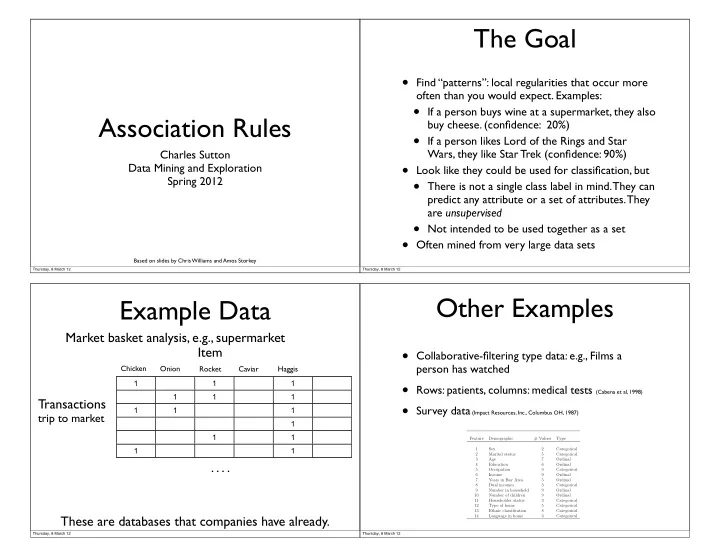

The Goal • Find “patterns”: local regularities that occur more often than you would expect. Examples: • If a person buys wine at a supermarket, they also Association Rules buy cheese. (confidence: 20%) • If a person likes Lord of the Rings and Star Wars, they like Star Trek (confidence: 90%) Charles Sutton • Look like they could be used for classification, but Data Mining and Exploration Spring 2012 • There is not a single class label in mind. They can predict any attribute or a set of attributes. They are unsupervised • Not intended to be used together as a set • Often mined from very large data sets Based on slides by Chris Williams and Amos Storkey Thursday, 8 March 12 Thursday, 8 March 12 Other Examples Example Data Market basket analysis, e.g., supermarket Item • Collaborative-filtering type data: e.g., Films a person has watched Chicken Onion Rocket Caviar Haggis 1 1 1 • Rows: patients, columns: medical tests (Cabena et al, 1998) 1 1 1 Transactions • Survey data (Impact Resources, Inc., Columbus OH, 1987) 1 1 1 trip to market 1 1 1 Feature Demographic # Values Type 1 1 1 Sex 2 Categorical 2 Marital status 5 Categorical 3 Age 7 Ordinal . . . . 4 Education 6 Ordinal 5 Occupation 9 Categorical 6 Income 9 Ordinal 7 Years in Bay Area 5 Ordinal 8 Dual incomes 3 Categorical 9 Number in household 9 Ordinal 10 Number of children 9 Ordinal 11 Householder status 3 Categorical 12 Type of home 5 Categorical 13 Ethnic classification 8 Categorical These are databases that companies have already. 14 Language in home 3 Categorical Thursday, 8 March 12 Thursday, 8 March 12
Itemsets, Coverage, etc Toy Example • Call each column an attribute A 1 , A 2 , . . . A m • An item set is a set of attribute value pairs Day Outlook Temperature Humidity Wind PlayTennis D1 Sunny Hot High False No ( A i 1 = a j 1 ) ∧ ( A i 2 = a j 2 ) ∧ . . . ( A i k = a j k ) D2 Sunny Hot High True No D3 Overcast Hot High False Yes • Example: In the Play Tennis data D4 Rain Mild High False Yes ( Humidity = Normal ∧ Play = Yes ∧ Windy = False ) = D5 Rain Cool Normal False Yes D6 Rain Cool Normal True No • The support of an item set is its frequency in the data set D7 Overcast Cool Normal True Yes D8 Sunny Mild High False No • Example: D9 Sunny Cool Normal False Yes D10 Rain Mild Normal False Yes • support ( ) = 4 ( Humidity = Normal ∧ Play = Yes ∧ Windy = False ) = D11 Sunny Mild Normal True Yes D12 Overcast Mild High True Yes • The confidence of an association rule if Y=y then Z=z is D13 Overcast Hot Normal False Yes P ( Z = z | Y = y ) • Example: D14 Rain Mild High True No P ( Windy = False ∧ Play = Yes | Humidity = Normal ) = 4 / 7 Thursday, 8 March 12 Thursday, 8 March 12 Item sets to rules Finding Frequent Itemsets • First: We will find frequent item sets • Then: We convert them to rules • Task: Find all item sets with support • An itemset of size k can give rise to 2 k -1 rules • Insight: A large set can be no more frequent than • Example: itemset its subsets, e.g., support(Wind = False) ≥ support(Wind = False, Outlook = Sunny) Windy=False, Play=Yes, Humidity=Normal • Results in 7 rules including: • So search through itemsets in order of number of items IF Windy=False and Humidity=Normal THEN Play=Yes (4/4) IF Play=Yes THEN Humidity=Normal and Windy=False (4/9) IF True THEN Windy=False and Play=Yes and Humidity=Normal (4/14) • An efficient algorithm for this is APRIORI (Agarwal • We keep rules only whose confidence is greater and Srikant, 1994; Mannila et al, 1994) than a threshold Thursday, 8 March 12 Thursday, 8 March 12
APRIORI Algorithm � Single database pass is linear in | C i | n , make a pass for each i until C i is empty � Candidate formation (for binary variables) � Find all pairs of sets { U , V } from L i such that U ∪ V has i = 1 size i + 1 and test if this union is really a potential C i = {{ A }| A is a variable } candidate. O ( | L i | 3 ) while C i is not empty database pass: � Example: 5 three-item sets for each set in C i test if it is frequent (ABC), (ABD), (ACD), (ACE), (BCD) let L i be collection of frequent sets from C i Candidate four-item sets candidate formation: (ABCD) ok let C i + 1 be those sets of size i + 1 all of whose subsets are frequent (ACDE) not ok because (CDE) is not present above end while Thursday, 8 March 12 Thursday, 8 March 12 Comments • Some association rules will be trivial, some interesting. Need to sort through them • Example: pregnant => female (confidence: 1) • Also can miss “interesting but rare” rules • Example: vodka --> caviar (low support) • Really this is a type of exploratory data analysis • For rule A -->B, can be useful to compare P(B|A) to P(B) • APRIORI can be generalised to structures like subsequences and subtrees Thursday, 8 March 12
Recommend
More recommend